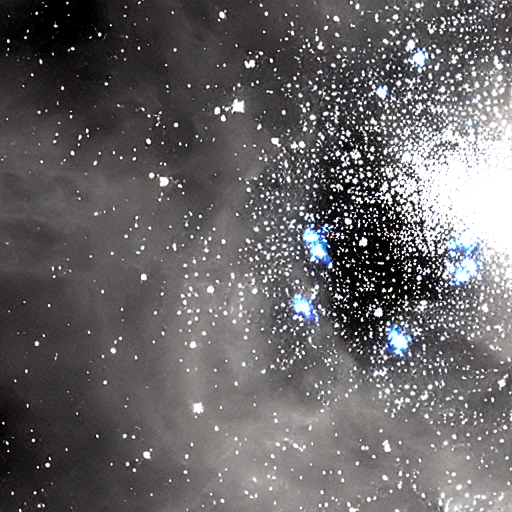Hubble Diffusion v1: Stable Diffusion v1.4 fine tuned on ESA Hubble Deep Space Images & Captions
Put in a detailed text prompt and generate Hubble Deep Space Images!
Hubble captures the death of a star: Old stars, nearing the end of their life, collapse under the weight of their own gravity and the outer layers explode as a 'supernova'. In this image Hubble captures the moments after collapse, where the star has exploded and left an empty void in its place, where a new black hole has emerged.
Hubble snaps images of the birthplace of stars within a cluster: The dust and gas expand within the cluster due to the powerful influence of baby stars. With these new images comes improved detail and a clearer view for astronomers to study how early stars are born and change over time.
Hubble image of galaxies colliding: The distorted spirals of two distant galaxies colliding are captured here in a new image from the NASA/ESA Hubble Space Telescope. The typically symmetric spirals common in spiral galaxies appear significantly warped, as the shape of both galaxies is torn apart by their gravitational pulls.
Model Details
- Developed by: Maxwell Weinzierl
- Model type: Diffusion-based text-to-image generation model
- Language(s): English
- License: The CreativeML OpenRAIL M license is an Open RAIL M license, adapted from the work that BigScience and the RAIL Initiative are jointly carrying in the area of responsible AI licensing. See also the article about the BLOOM Open RAIL license on which our license is based.
- Model Description: This is a model that can be used to generate and modify images based on text prompts. It is a Latent Diffusion Model that uses a fixed, pretrained text encoder (CLIP ViT-L/14) as suggested in the Imagen paper, with initial weights from CompVis/stable-diffusion-v1-4. It was fine-tuned on Supermaxman/esa-hubble.
- Resources for more information: GitHub Repository, Paper.
- Cite as:
@misc{weinzierl2023sdhubble1,
author = {Weinzierl, Maxwell A.},
title = {Hubble Diffusion v1: Stable Diffusion v1.4 fine tuned on ESA Hubble Deep Space Images & Captions},
year={2023},
howpublished= {\url{https://huggingface.co/Supermaxman/hubble-diffusion-1}}
}
Also, be sure to check out the new and improved Hubble Diffusion v2!
Examples
We recommend using 🤗's Diffusers library to run Hubble Diffusion.
Usage
pip install transformers diffusers accelerate
import torch
from diffusers import StableDiffusionPipeline
model_id = "Supermaxman/hubble-diffusion-1"
pipe = StableDiffusionPipeline.from_pretrained(model_id, torch_dtype=torch.float16)
pipe = pipe.to("cuda")
# saves significant GPU memory for small inference cost
pipe.enable_attention_slicing()
prompt = "Hubble snaps images of the birthplace of stars within a cluster: The dust and gas expand within the cluster due to the powerful influence of baby stars. With these new images comes improved detail and a clearer view for astronomers to study how early stars are born and change over time."
image = pipe(prompt).images[0]
image
Model description
Trained on ESA Hubble Deep Space Images & Captions using Google Colab Pro with a single A100 GPU for around 33,000 steps (about 12 hours, at a cost of about $20).
Links
- Captioned Hubble Deep Space Scans dataset
- Model weights in Diffusers format
- Training code
- Hubble Diffusion v2
Trained by Maxwell Weinzierl (@Supermaxman1).
Citation
@misc{weinzierl2023sdhubble1,
author = {Weinzierl, Maxwell A.},
title = {Hubble Diffusion v1: Stable Diffusion v1.4 fine tuned on ESA Hubble Deep Space Images & Captions},
year={2023},
howpublished= {\url{https://huggingface.co/Supermaxman/hubble-diffusion-1}}
}
- Downloads last month
- 9



